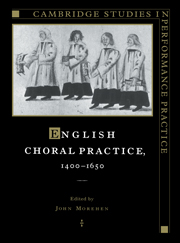Book contents
- Frontmatter
- Contents
- List of plates
- General preface
- Preface
- Abbreviations
- 1 To chorus from quartet: the performing resource for English church polyphony, c. 1390–1559
- 2 Editing and performing musica speculativa
- 3 The sound of Latin in England before and after the Reformation
- 4 English pronunciation, c. 1500 – c. 1625
- 5 Byrd, Tallis and Ferrabosco
- 6 John Baldwin and changing concepts of text underlay
- 7 Sacred songs in the chamber
- 8 The education of choristers in England during the sixteenth century
- 9 The ‘burden of proof’: the editor as detective
- Index of names and places
- Index of manuscript and printed music sources
- Index of works cited
1 - To chorus from quartet: the performing resource for English church polyphony, c. 1390–1559
Published online by Cambridge University Press: 03 March 2010
- Frontmatter
- Contents
- List of plates
- General preface
- Preface
- Abbreviations
- 1 To chorus from quartet: the performing resource for English church polyphony, c. 1390–1559
- 2 Editing and performing musica speculativa
- 3 The sound of Latin in England before and after the Reformation
- 4 English pronunciation, c. 1500 – c. 1625
- 5 Byrd, Tallis and Ferrabosco
- 6 John Baldwin and changing concepts of text underlay
- 7 Sacred songs in the chamber
- 8 The education of choristers in England during the sixteenth century
- 9 The ‘burden of proof’: the editor as detective
- Index of names and places
- Index of manuscript and printed music sources
- Index of works cited
Summary
In respect of the choral music of the church services in England, the fifteenth century witnessed a revolution in performance practice which established fundamental premises that have endured to the present day. At a point around 1390, the opening of the period under review here, choral execution in the music of the Church was a feature of the performance only of plainsong. The rendering of polyphonic music was the province exclusively of small ensembles of soloists, all adult males. By the end of the fifteenth century polyphony for performance by chorus, composed to a standard texture of five voices but not uncommonly for more, had emerged as one of the principal splendours of church practice in England, and involved the voices of the boys of liturgical choirs as well as those of the men. During the course of the century choirs originally constituted primarily to sing just the plainsong liturgy were perforce so re-modelled as to ensure supply of the resources, in terms both of personnel and of training, appropriate for the new musical medium. Correspondingly, founding authorities drawing up the constitutions of choirs newly established ensured that such provision was among their first priorities. Overall, the joint achievement of founders, chapters, composers and singers during this century was to develop and establish perhaps the most enduring of all vehicles for the performance of art music, namely the four-timbre chorus of treble, alto, tenor and bass voices – a concept over which the experience of 500 years and more has not been able to cast any substantive improvement.
- Type
- Chapter
- Information
- English Choral Practice, 1400–1650 , pp. 1 - 47Publisher: Cambridge University PressPrint publication year: 1996
- 2
- Cited by

